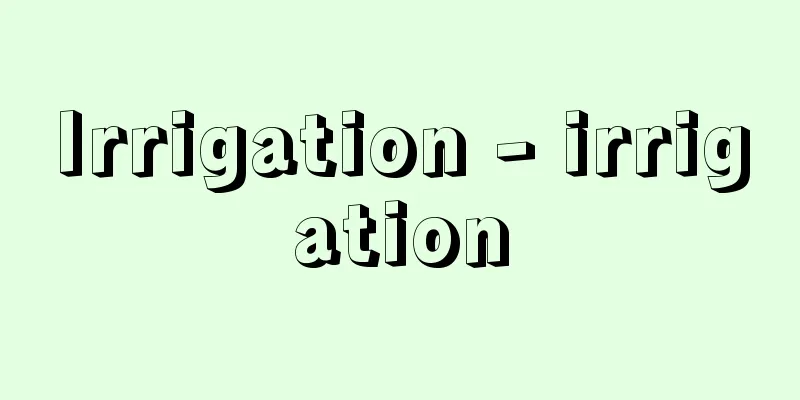Irrigation - irrigation

|
The artificial pouring of water into farmland. Plants, not just crops, grow by absorbing several hundred times the amount of water their dry matter weight (the increase in living weight due to growth minus the water weight) through their roots and evaporating it through their leaves (a process called transpiration). If the amount of rainfall is just right for the crop's water needs, there is no need for irrigation (this type of crop cultivation is called rain-fed agriculture). However, in arid regions where the annual rainfall is generally 500 mm or less (such as the Middle East and North Africa), it is difficult to grow crops without irrigation, and even in humid, rainy regions where the annual rainfall distribution is unsuitable for growing crops (such as Southeast Asia, including Japan), irrigation is necessary. The purpose of irrigation is, first and foremost, to artificially supply the water needed for crop growth by supplementing rainfall, but it is not limited to that purpose. As cultivation techniques have advanced, irrigation has come to be used for a variety of purposes. For example, when applying fertilizers, pesticides, or weeding, it is becoming common to reduce the labor required by spraying water in which fertilizers or pesticides have been dissolved. In some areas, irrigation is used to remove salt, prevent salt damage from sea breezes, prevent high temperature damage, prevent frost damage, and prevent cold temperature damage, and in some cases to increase the efficiency of tasks such as sowing, tilling, transplanting, and harvesting. These are called multipurpose irrigation. Irrigation water has long been used for daily life purposes such as washing clothes, but in recent years, with the increase in greenhouse gardening and livestock farming, irrigation water has also been used for these purposes. As a result, irrigation water has come to be used for general water needs in rural areas. [Hiroyasu Shimura and Masahiko Tomita] Paddy field irrigation and upland field irrigationIrrigation can be broadly divided into paddy field irrigation and upland field irrigation. The difference between the two is mainly in the water management and the amount of water required. Paddy field irrigation is carried out to keep paddy fields constantly flooded, so in Japan, it is irrigated almost every day. In some areas, water is left in the paddy fields for a long time, a practice known as "run-off". Water management for paddy fields is generally more extensive than for upland fields, and the amount of water required is also greater. The amount of water required for paddy field irrigation is mainly determined by the water drawdown (the value per day at which the paddy water level drops when no water is supplied; the sum of evapotranspiration and infiltration). In Japan, it varies by region, but is often around 20 mm. In this case, the unit water requirement (the basic unit for water supply) is about 2 liters per second per hectare. In paddy fields in Southeast Asia and Europe and the United States outside of Japan, the unit water requirement is generally estimated at about 1 liter per second per hectare. Outside of Japan, intermittent irrigation, in which water is supplied every few days, is common for paddy field irrigation. Field irrigation generally involves rehydrating the soil while also using the multipurpose water mentioned above; in Japan, this is intermittent irrigation, with water supplied roughly every 4-6 days. In Japan, sprinklers and other watering devices are commonly used, but outside of Japan, furrow irrigation or border irrigation, in which water is poured widely over the surface of the farmland, is more common. Water management for fields is more intensive than for paddy fields, but the amount of water required is much smaller than for paddy fields. The amount of water required for field irrigation in Japan varies by crop and region, but is about 2-5 mm per day when there is no rainfall, and 10-30 mm per irrigation, with a unit water requirement of about 0.2-0.5 liters per second per hectare. The amount of water used for farmland around the world varies greatly from country to country, but many places use less than Japan. In Japan, paddy field irrigation also switches to intermittent irrigation every two to three days during droughts. Water supply areas are divided and water is circulated in turns. This is called bansui. At this time, water management becomes stricter, but the amount of water supplied to the region as a whole decreases. In Taiwan, paddy fields and upland fields are rotated, and paddy irrigation and upland irrigation are alternated periodically. In such cases, paddy fields also use intermittent irrigation, which also requires strict water management, but it is effective in saving water and preventing problems with continuous cropping of fields. [Hiroyasu Shimura and Masahiko Tomita] Irrigation SystemsTo implement irrigation, a series of large-scale systems including water source facilities, water conveyance facilities, and water distribution facilities are required. These are the grand irrigation facilities and water management mechanisms that have been established in irrigated areas around the world since ancient times. Currently, Japan's irrigation water sources, expressed as a percentage of irrigated area, are 88% rivers, 10% reservoirs, and 2% groundwater, so it is overwhelmingly river-dependent. Southeast Asian countries are close to this, but there are also regions such as Sri Lanka where reservoirs are the main water source. In arid regions, there are also countries where groundwater is the main water source. In Japan, drought flow was almost fully utilized during the Edo period, so in modern times, dams are necessary to develop new irrigation systems. Irrigation systems are broadly divided into core facilities (dams, head works or pumping stations that take water from rivers, main canals, and system control centers), branch facilities (facilities that divert water from the main canals and convey it to villages), and village field facilities (facilities that distribute water to each field in a village). In modern Japan, these facilities are managed by land improvement districts organized by all the farmers in the irrigation area, but village field facilities are left to the villages, which are traditional water users' communities. However, because the construction and renovation of these facilities has a strong public nature and requires advanced technical skills, core facilities are usually managed as national projects, branch facilities as prefectural projects, and village field facilities as land improvement district projects, based on the initiative of the land improvement district. Irrigation systems in other countries around the world are similar to those in Japan, although to varying degrees, but management varies significantly depending on the circumstances of each country. However, many are managed by public agencies or farmer organizations, and some are corporate-run. According to agricultural hydrology expert Ogata Hiroyuki (1919- ), there are two opposing types of water distribution principles for irrigation systems. One is water distribution that responds to the demands of water users (farmers) (demand-driven), and the other is water distribution that matches the water resource situation (supply-driven). The former is more likely to occur in areas with abundant and stable water resources, while the latter is more likely to occur in areas with scarce or unstable water resources. Irrigation in Japan is of the former type at all times and the latter type during droughts. Irrigation in Taiwan and other countries can be said to be of the latter type all the time. [Hiroyasu Shimura and Masahiko Tomita] Irrigation and land use/conservationIrrigation improves and stabilizes the productivity of farmland, reducing the amount of farmland required per person and creating a nation that can accommodate multiple uses of land and a high population density. The effects of this are particularly evident in Southeast Asian countries, including Japan, where paddy field irrigation is well developed. As irrigation is implemented, farmland is improved and management is usually strengthened, which in turn strengthens the conservation function of farmland as a whole. In particular, with paddy field irrigation, the construction of ridges is improved, which strengthens the water storage function of paddy fields during heavy rains. Flood control measures against heavy rains are crucial in monsoon regions of Asia, and through paddy field irrigation, large areas of farmland effectively serve as flood control facilities. When irrigation is implemented over a large area, it can affect the natural water cycle, and if it is not properly planned, it can destroy the balance of the ecosystem and cause other negative consequences, including diseases. Several such cases have occurred in the development of irrigation around the world since World War II, but one of the most serious and well-known cases is the drying up of the Aral Sea in Central Asia. The rich streams of the Amu Darya and Syr Darya that flow into the Aral Sea were diverted on a large scale for irrigation of cotton fields due to the large-scale development of cotton fields in the former Soviet Union, and the amount of water flowing into the Aral Sea was greatly reduced. As a result, the water level of the Aral Sea gradually decreased, and by around 1990, the area of the Aral Sea had shrunk to one-third of its original size. With the collapse of the former Soviet Union, information became available, and the serious situation of the Aral Sea fishery being devastated was exposed to the world's attention. This is a crucial example showing the importance of environmental assessments in irrigation development, but irrigation should essentially be carried out over a long period of time in a way that is integrated with nature, and the true essence of irrigation planning is the continuous accumulation of improvements. At present, the world's irrigated area is about 200 million hectares, which is only about 13% of the total agricultural land area and about 1% of the total land area, but with a rapid increase in the world's population predicted in the future, especially in developing countries, irrigation is likely to become even more important. [Hiroyasu Shimura and Masahiko Tomita] historyThe technology of artificially irrigating land is very old in human history, and it did not necessarily exist after the emergence of agriculture. For example, the indigenous Paiutes who lived on the dry plateau of the Rocky Mountains in North America did not know agriculture and made a living by gathering wild food. However, they knew how to artificially draw meltwater into the areas where certain plants grow, from which they harvest seeds and bulbs, to increase their yields. Large-scale irrigation requires not only the securing of large amounts of water, but also advanced technology such as the construction and maintenance of water channels, and a social organization capable of carrying out large-scale cooperative work. However, if it is only necessary to pump water from small reservoirs or wells using human or animal power and draw it into the land, it is carried out by individual farmers or small communities in arid regions all over the world. Irrigation, which began in Western Asia around 6000 BC, was initially on a small scale like this, and was attempted by trial and error by early farmers who expanded from relatively humid mountainous areas to dry, hot plains, and it is said that no permanent irrigation channels were developed. As this expansion into the plains continued, irrigation became more extensive and systematic, and it is well known that this process was closely linked to the establishment of urban civilization in the region. Today, most of the land at the birthplace of Sumerian urban civilization has become barren and unsuitable for cultivation, a result of the alkalization of the land caused by excessive irrigation and inadequate drainage. In the long run, the large-scale irrigation that supported early civilization also had its downsides. It is only relatively recently that rational, large-scale irrigation methods centered on the comprehensive management of land and water have been established. As was seen in the 1970s among the indigenous Navajo people of North America, poor water management techniques meant that they were unable to make effective use of modern irrigation systems, and so faced serious problems such as the alkalization of the land, illustrating the difficulties of irrigation. [Mitsuru Hamamoto] JapanThe history of irrigation in Japan is parallel to the history of rice paddy development. When rice was introduced to Japan in the Jomon period, when people lived on the plateau with yams, chestnuts and other nuts as their staple food, it spread within a century and led to the development of the Yayoi culture based on rice cultivation. The remains of rice paddies such as Toro (Shizuoka Prefecture) and Lake Dainaka (Shiga Prefecture) were well known as such, but since the 1980s, large-scale ruins including rice paddy remains have been discovered one after another all over the country, making it clear that rice cultivation had already spread to the Tsugaru Peninsula in the early Yayoi period. At that time, rice paddies were mainly made from natural wetlands, but at the end of the Yayoi period, the use of iron extended to the cutting edges of agricultural tools, which increased the capacity of earthworks, and the development of rice fields led to the increase in irrigation channels and reservoirs, forming a rice-growing nation. The Kojiki records the construction of Chinuike Pond and Sayamaike Pond (Osaka Prefecture) during the reign of Emperor Suinin. After that, the development of rice fields, accompanied by irrigation channels (nationwide) and reservoirs (particularly common in Kagawa Prefecture), continued uninterruptedly, and many of these have been restored and improved and are still in use today. During the Sengoku period in particular, stonemasonry techniques for castle construction were developed and applied to flood control works on major rivers, and floodplains (alluvial plains) such as the Tone River and Yodo River were converted into rice paddies, changing the country's land area to its present-day form. The Minumadai Canal (Saitama Prefecture) and Miyata Canal (Aichi Prefecture) are well-known examples. After the Meiji period, Western civil engineering techniques were used to convert plateaus into rice paddies through irrigation, including the Meiji Canal (Aichi Prefecture), Asaka Canal (Fukushima Prefecture), and Nasu Canal (Tochigi Prefecture). After World War II, irrigation of this plateau was extended to field crops as well, and construction of large-scale irrigation canals, including the Aichi Irrigation Canal (Aichi Prefecture), Toyokawa Irrigation Canal (Aichi Prefecture), and Kasanohara Irrigation Canal (Kagoshima Prefecture), was started one after another as national projects. From around 1980, there was an increase in small and medium-sized developments on the scale of prefectural projects, and irrigation of field crops in Japan progressed rapidly. [Masahiko Tomita] "Agricultural Civil Engineering History Research Group, ed., 'Imprint on the Earth' (1988, Public Works Press)" ▽ "Shimura Hiroyasu, ed., 'The Local Characteristics and Modernization of Water Resources' (1992, University of Tokyo Press)" [Reference items] | | | | | |Source: Shogakukan Encyclopedia Nipponica About Encyclopedia Nipponica Information | Legend |
|
農地に人為的に水を注ぐこと。作物に限らず一般に植物は増加乾物重(成長に伴う生体重量増加分から含水重量を除いたもの)の数百倍の水を根から吸収して葉から蒸発させ(蒸通発という)ながら成長する。この作物の必要水量に都合よく雨が降れば、あえて灌漑する必要はない(そのような作物栽培を天水農業という)。しかし一般に年降水量が500ミリメートル以下の乾燥地域(たとえば中東、北アフリカ地域など)では灌漑なしには作物栽培は困難であり、湿潤多雨地域でも年間の降雨分布が作物栽培上不適当な地域(たとえば日本を含めた東南アジア地域など)では灌漑が必要となる。 灌漑の目的は、まず作物の生育に必要な水を、降雨を補って人為的に供給することであるが、それに限られるものではない。栽培技術の進歩に伴って多様な目的に使われるようになっている。たとえば施肥、農薬散布、除草などに際して、肥料や薬剤を溶かした水を散布する方法で省力化することが多くなってきており、地域によっては除塩、潮風塩害防止、高温障害防止、凍霜害防止、冷温障害防止などのために灌漑を行うし、さらに播種(はしゅ)、耕うん、移植、収穫などの作業能率をあげるために灌漑を行う場合もある。これらは多目的灌漑と称される。 古くから灌漑用水は洗濯など生活用水としても用いられてきたが、近年では施設園芸や畜産の増加に伴い、それらの用水としても用いられる。その結果、灌漑はいまや農村地域の総合用水という性格のものになっている。 [志村博康・冨田正彦] 水田灌漑と畑地灌漑灌漑は大別して水田灌漑と畑地灌漑とに分けられる。両者の違いはおもに水管理と用水量の差に現れる。水田灌漑は水田での常時湛水(たんすい)を目的として行われるので、日本ではほぼ毎日の連続的灌漑となる。地域によっては、かけ流しといって、水田に水を入れっぱなしにする場合もある。水田の水管理は一般に畑に比べて粗放的となり、用水量も大きな値となる。水田灌漑の必要水量は主として減水深(給水しない場合に水田湛水位が低下する1日当りの値。蒸発散量と浸透量の和)で規定される。日本では、地域によって異なるが20ミリメートル前後の値になることが多い。その場合の単位用水量(給水のための原単位)はヘクタール当り約2リットル/秒となる。日本以外の東南アジアや欧米の水田では単位用水量を概算値としてヘクタール当り約1リットル/秒とするのが一般的である。日本以外では水田灌漑においても数日おきに給水する間断灌漑が一般的である。 畑地灌漑は土壌への水分補給を図りつつ、あわせて先述の多目的水利用を行うのが一般的で、日本では、だいたい4~6日おきに給水する間断灌漑である。日本ではスプリンクラーなど散水装置を用いるのが一般的であるが、日本以外では、畝間(うねま)灌漑、あるいは農地表面に広く水を流し込むボーダー灌漑が一般的である。畑の水管理は水田に比べて集約的となるが、用水量は水田に比べてかなり小さい。日本での畑地灌漑用水量は、作物や地域によって異なるが無降雨時1日当り約2~5ミリメートル、1回の灌水が10~30ミリメートルで、単位用水量はヘクタール当り約0.2~0.5リットル/秒である。 世界の畑地の用水量は国によってまったく異なるが、日本より少ない所が多い。日本の水田灌漑においても、渇水時には2~3日おきの間断灌漑に移行する。給水区を分け、順繰りに水を回す。これを番水(ばんすい)という。このとき、水管理は厳しくなるが、給水量は地域全体として減少する。台湾では、水田と畑を輪作にして、水田灌漑と畑地灌漑を周期的に交代させる。このような場合は水田も間断灌漑となり、これも厳しい水管理となるが、節水と畑の連作障害防止に効果的である。 [志村博康・冨田正彦] 灌漑システム灌漑を実施するためには、水源施設、送水施設、分配水施設などを備えた一連の大システムが必要となる。世界的に古代から灌漑地域に設けられてきた壮大な灌漑施設と水管理機構がこれである。日本の灌漑水源は現在、灌漑面積の割合で表示して、河川88%、溜池(ためいけ)10%、地下水2%で、圧倒的に河川依存型である。東南アジア諸国はほぼこれに近いが、スリランカのように溜池を主水源とする地域もある。乾燥地域では地下水が主水源の国もある。日本の河川利用では、すでに江戸時代にほぼ渇水流量を利用し尽くしたので、現代では新たに灌漑開発するにはダムをつくる必要がある。 灌漑システムは、基幹的施設(ダム、河川から取水する頭首工あるいは揚水機場、幹線水路およびシステム管理センター)、支線的施設(幹線水路から分水して集落まで送水する諸施設)、集落内圃場(ほじょう)施設(集落の各圃場への配水を行う諸施設)に大別される。これらの施設の管理は、現代の日本では、灌漑地域の農業者全員で組織された土地改良区によって行われるが、集落内圃場施設については伝統的な水利共同体である集落に任せられる。しかし、これら施設の建設・改造は公共性が強く、かつ高度の技術力を必要とするので、土地改良区の発議に基づいて、基幹施設は国営事業、支線的施設は都道府県営事業、集落内圃場的施設は土地改良区営事業として行われるのが常である。世界各国の灌漑システムも、程度の差こそあれ、日本のそれとほぼ似ているが、管理については国の事情により著しく異なる。しかし公共機関または農業者組織による管理が多く、なかには企業的経営の場合もある。 農業水利学者の緒形博之(おがたひろゆき)(1919― )の指摘によれば、灌漑システムの配水原則には二つの対極的型がある。一つは水使用者(農業者)の要求に即応する配水(需要サイド主導型)、いま一つは水源状況にあわせた配水(供給サイド主導型)である。水源が豊富・安定な地域では前者になりやすく、不足・不安定な地域では後者になりやすい。日本の灌漑は、常時には前者、渇水時には後者となる。台湾などの灌漑は常時後者だといえる。 [志村博康・冨田正彦] 灌漑と国土の利用・保全灌漑を通じて農地の生産性が向上し、安定化するため、国民1人当りの必要農地面積が減少し、土地の多面的利用と高い人口密度を許容する国土がつくられる。とくに水田灌漑の発達した東南アジア諸国では、日本を含めて、その効果が顕著に現れている。 灌漑の実施とともに圃場の整備が進み、圃場の管理も強化されるのが常であるが、それらに伴って農地の保全機能が全体として強化される。とくに水田灌漑では畦畔(けいはん)の整備が進むため、水田のもつ豪雨時の貯水機能が強化される。アジアモンスーン地域では治水上豪雨対策が重大であるが、水田灌漑を通じて広範な農地が事実上治水施設の役割を果たしている。 灌漑が広い地域で実施された場合、自然の水循環に影響を及ぼすことになるが、不適切に計画された場合には生態系のバランスを壊し、病気などをも含めて悪い結果をもたらすこともある。第二次世界大戦後の世界の灌漑開発ではいくつかそのようなことが生じているが、とくに深刻なものとして世界に知れ渡ったものに中央アジアのアラル海の干上がりがあげられる。アラル海に流入するアムダリヤとシルダリヤの豊かな流れは、旧ソ連の大規模な綿花畑開発に伴って綿花畑の灌漑のために大規模に取水されて、アラル海へ流入する水量が大幅に減少していった。それに伴ってアラル海の水位はじりじりと低下していき、1990年ころにはアラル海の面積は元の3分の1にまで縮小した。旧ソ連の崩壊によって情報が得られるようになり、アラル海漁業が壊滅状態に陥っている深刻な状況が世界の目にさらされた。灌漑開発には環境アセスメント(環境影響評価)がたいせつなことを示す重い例であるが、灌漑は本来長い期間をかけて自然と一体化するように行われるべきものであり、むしろ絶えざる改良の積み重ねが灌漑計画の本質である。現在、世界の灌漑面積は約2億ヘクタールで全農地面積の約13%、陸地総面積の約1%にとどまるが、今後世界人口の急増がとくに開発途上国において予測されているので、灌漑はますます重視されてくるであろう。 [志村博康・冨田正彦] 歴史土地に対して人為的に給水する技術自体は、人類の歴史においてきわめて古く、またかならずしも農耕の発生以後のことでもない。たとえば、北アメリカのロッキー山中の乾燥した高原に住む先住民パイユートは、農耕を知らず野生の食物採集を生業としていたが、ある種の草の実や球根をとる植物の群生地に、雪解け水を人為的に引いて、それらの収量をあげることは知っていた。大規模な灌漑には、大量の水の確保に加え、導水路を整備し維持するなど、進んだ技術と大規模な共同作業を実施することのできる社会組織が必要となるが、小規模な貯水池や井戸から、人力や畜力を用いて揚水し土地に引くだけのことなら、個々の農民や小共同体によって世界各地の乾燥地帯で行われている。西アジアで紀元前6000年ごろから始まった灌漑も、当初はこのような小規模なもので、比較的湿潤な山岳地帯から乾燥高温の平野部に拡大してきた初期の農耕民たちの手で、試行錯誤的に試みられたものであるらしく、恒久的な用水路の発達はみられなかったという。この平野部への拡大が進行するにしたがい、灌漑もより大規模にまた組織的なものになったが、この過程がこの地方での都市文明の成立に密接に結び付いていたのは周知の事実である。 今日、シュメールの都市文明発祥地の土地は、ほとんどが耕作に適さぬ荒れ地となっているが、これは過度の灌漑と不適切な排水による土地のアルカリ化の結果であるという。初期文明を支えた大規模灌漑には、長い目でみると、こうしたマイナス面もあったのである。土地と水の総合管理を中心とする、合理的で大規模な灌漑法が確立したのは、むしろ比較的最近のことである。1970年代、北アメリカの先住民ナバホの間でみられたように、水管理技術のまずさなどのため、近代的な灌漑システムを有効に使いこなせず、土地のアルカリ化などの深刻な問題に直面した例など、灌漑のむずかしさを物語っている。 [濱本 満] 日本日本の灌漑の歴史は水田開発の歴史と軌を一にしている。ヤマイモ、クリなどの木の実を主食として台地上に人々の暮らしが展開していた縄文時代までのわが国にイネがもたらされると、1世紀を経ずして普及し、稲作に基礎を置く弥生(やよい)文化を開花させた。登呂(とろ)(静岡県)、大中の湖(だいなかのこ)(滋賀県)などの水田遺構はその跡としてつとに名が知られていたが、1980年代以降次々と全国各地で水田遺構を含む大規模な遺跡の発見が続いて、弥生時代の早い時期に稲作はすでに津軽半島にまで及んでいたことが明らかになってきた。このころの水田は自然湿地の利用が主であったが、弥生時代末期になって鉄の使用が農具の刃先にまで及ぶと土工能力が高まり、開田が灌漑水路や溜池を増大して稲作国家を形成していった。『古事記』にある垂仁(すいにん)天皇時代の血沼(ちぬ)池、狭山(さやま)池(大阪府)の構築などはその記録である。その後、灌漑水路(全国的)、溜池(香川県にとくに多い)を伴う開田は連綿と続き、その多くは修復、改良を重ねながら現在も用いられている。とくに戦国時代に築城のための石工技術が発達し、これが大河川の治水工事に応用されるとともに利根(とね)川、淀(よど)川などの氾濫(はんらん)原(沖積平野)も水田化され、国土をほぼ現在の姿に変えた。見沼代(みぬまだい)用水(埼玉県)、宮田用水(愛知県)などはつとに有名。明治以降は西洋土木技術を活用して明治用水(愛知県)、安積(あさか)疎水(福島県)、那須(なす)疎水(栃木県)をはじめ、灌漑による台地の水田化が進んだ。この台地への灌漑は第二次世界大戦後に至って畑作にも及び、愛知用水(愛知県)、豊川用水(愛知県)、笠野原用水(鹿児島県)をはじめ大規模用水が国営事業のかたちで次々と着工され、1980年ころからは県営事業クラスの中小規模の開発も多くなって、わが国畑作の灌漑化が急速に進展した。 [冨田正彦] 『農業土木歴史研究会編著『大地への刻印』(1988・公共事業通信社)』▽『志村博康編『水利の風土性と近代化』(1992・東京大学出版会)』 [参照項目] | | | | | |出典 小学館 日本大百科全書(ニッポニカ)日本大百科全書(ニッポニカ)について 情報 | 凡例 |
Recommend
Communist Party of Vietnam (English: Dang Cong San Viet Nam)
A political party in the Socialist Republic of Vi...
Hemerocallis fulva (English spelling) Hemerocallisfulva
… [Mitsuru Hotta]... *Some of the terminology tha...
Akadama Shinkyogan - Akadama Shinkyogan
...In 1843 (Tenpo 14), the townscape of this post...
Hyacinthus orientalis; common hyacinth
A perennial plant of the lily family. Native to As...
Irohaya rental book store - Irohaya rental book store
...Their old collections are currently one of the...
The Twelve Olympians
→ The Twelve Olympians Source : Heibonsha Encyclop...
Nimrud (English spelling)
Located on the east bank of the Tigris River, abou...
monsoon trough
…The most important of these is the southwest mon...
Diaphragm process
A method for producing chlorine and sodium hydroxi...
Trier, J.
...However, this type of analysis has progressed ...
Ivanovo (English spelling)
Ivanovo-Voznesensk until 1932. Capital of Ivanovo ...
History - History
〘noun〙① A full cycle on the calendar. A new year. ...
calcined coke
…The volatile matter can be removed by heating th...
Shou-xian ancient tomb - Shou-xian gu-mu
A group of tombs from the Spring and Autumn Period...
Akiami (Autumn shrimp) - Acetes japonicus
Although it has the name "Mysidae," it i...









